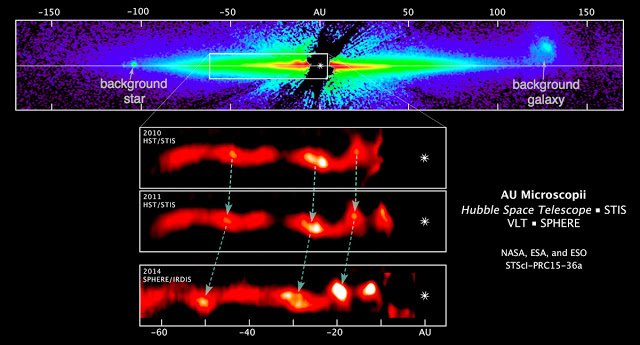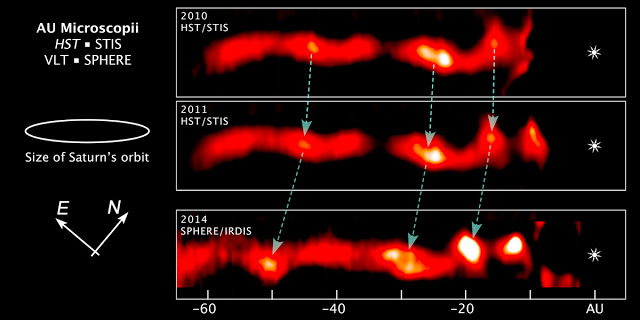| Online: | |
| Visits: | |
| Stories: |

| Story Views | |
| Now: | |
| Last Hour: | |
| Last 24 Hours: | |
| Total: | |
Mysterious Ripples Found Racing Through Planet-Forming Disk
This set of images of a 40-billion-mile-diameter edge-on disk encircling the young star AU Microscopii reveals a string of mysterious wave-like features. When astronomers compared images from NASA’s Hubble Space Telescope, taken in 2010 and 2011, to a 2014 image from the European Southern Observatory’s Very Large Telescope, they discovered the ripples are moving across the disk at a speed of 22,000 miles per hour. Such high velocities rule out the possibility that these features are caused by planets or smaller objects in the disk. Pending further research, the phenomenon remains unknown. Such structures have never before been seen in stellar gas and dust disks. The images are false-colored to bring out structural details in the disk.

Credit for Top Panel: NASA, ESA, G. Schneider (Steward Observatory), and the HST GO 12228 team
Credit for Bottom Panels: NASA, ESA, ESO, and A. Boccaletti (Paris Observatory)
Astronomers have been searching AU Mic’s disk for any signs of clumpy or warped features that might offer evidence for planet formation. They discovered some very unusual, apparently outward-moving features near the star by using ESO’s SPHERE (Spectro-Polarimetric High-contrast Exoplanet Research) instrument, mounted on the Very Large Telescope.
“The images from SPHERE show a set of unexplained features in the disk, which have an arc-like, or wave-like structure, unlike anything that has ever been observed before,” said Anthony Boccaletti of the Paris Observatory, the paper’s lead author.
The images reveal a train of wave-like arches, resembling ripples in water. After spotting the features in the SPHERE data the team turned to earlier Hubble images of the disk, taken in 2010 and 2011. The wave-like nature of some of these features were not recognized in the initial Hubble observations. But once astronomers reprocessed the Hubble images they not only identified the features but realized that they had changed over time. The researchers report that these ripples are moving — and they are moving very fast.
“We ended up with enough information to track the movement of these strange features over a 3- to 4-year period,” explained team member Christian Thalmann of the Swiss Federal Institute of Technology in Zurich, Switzerland. “By doing this, we found that the arches are racing away from the star at speeds of up to 10 kilometers per second (22,000 miles per hour)!” Co-investigator Carol Grady of Eureka Scientific in Oakland, California, added, “Because nothing like this has been observed or predicted in theory we can only hypothesize when it comes to what we are seeing and how it came about.”
“One explanation for the strange structure links them to the star’s flares. AU Mic is a star with high flaring activity. This is typical for such young, relatively cool, low-mass stars. AU Mic often lets off huge and sudden bursts of energy from on or near its surface,” said co-author and leader of the Hubble team Glenn Schneider of Steward Observatory in Tucson, Arizona. “One of these flares could perhaps have triggered something on one of the planets — if there are planets — like a violent stripping of material, which could now be propagating through the disk, propelled by the flare’s force.”
The team plans to continue to observe the AU Mic system to try to understand what is happening. But, for now, these curious features remain an unsolved mystery.
The results will be published Oct. 8 in the British science journal Nature.
Contacts and sources:
Ray Villard, Space Telescope Science Institute, Baltimore, Maryland
Felicia Chou, NASA Headquarters, Washington, D.C.
Mathias Jäger, ESA/Hubble, Garching, Germany
Anthony Boccaletti, Paris Observatory, CNRS, Paris, France
Glenn Schneider, Steward Observatory, University of Arizona, Tucson, Arizona
Source:





